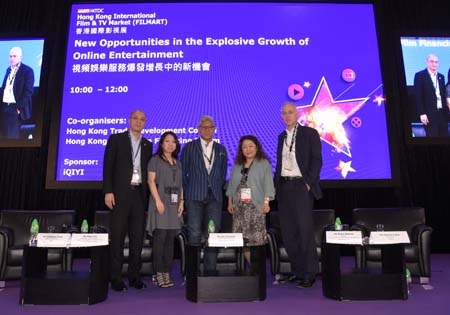With the rapid advances in technology, people can tune into their favourite OTT platforms on different kinds of electronic devices anytime and anywhere. At the thematic seminar New Opportunities in the Explosive Growth of Online Entertainment at the Hong Kong International Film and TV Market (FILMART), representatives of four renowned online entertainment companies discussed how […]

With the rapid advances in technology, people can tune into their favourite OTT platforms on different kinds of electronic devices anytime and anywhere. At the thematic seminar New Opportunities in the Explosive Growth of Online Entertainment at the Hong Kong International Film and TV Market (FILMART), representatives of four renowned online entertainment companies discussed how to tap into the tremendous OTT platform market by producing and sourcing quality localised content.
User pays model is key to business development
Yang Xianghua, Senior Vice President of iQIYI pinpointed the fast-growing audience for OTT platforms in the Chinese mainland over the past few years. It is estimated that within this year or next year, the number of people who watch streaming videos using mobile phone networks will reach half of the countrys population. In view of this, iQIYI is actively working with our partners to produce high-quality full-length online films.
He mentioned that there are two revenue models in place at present; advertisement revenue and user fees. The number of videos that generated more than Rmb1 million in profit for the company surged from 35 in 2015 to 122 in 2016, which points to a huge online market.
Conference moderator Patrick Frater, Asia Editor of Variety, raised the question of how to tackle the issue of many online entertainment companies running at a loss. In his response, Yang noted that iQIYI has invested a lot in purchasing and producing content. In order to attract audiences, a significant portion of the content is free in the early stages. However, he predicted that the platform will turn the deficit into profit, as the number of subscribers and page views increases and the pay-per-user model is established.
Young Chinese viewers are relatively affluent, so they are willing to pay for higher-quality content, he added.
Localised vision to meet demands of different markets
Meg Lee, Assistant Vice President, Content Management Digital Media, PCCW Media Limited summed up the current trend: Korean content is king. Therefore, ViuTV is closely following the Korean trends and actively sourcing quality Korean entertainment video content such as dramas and variety shows, which have attracted a large numbers of fans of Korean trends to follow the channel.
Regarding producing and sourcing content that caters to the tastes of local audiences, Lee noted: ViuTV has its own team in each country, as well as an independent team that is in charge of collecting audience data and analysis. We also work with different local companies so as to quickly grasp the demand of the local market. She added that ViuTV has its own team of translators who translate related content into local languages in a timely fashion.
We can only stay at the forefront by seizing the opportunities from the fast-changing trends.
Diversified video content attracts wider audiences
As audience tastes change quickly, companies need to constantly explore new initiatives and adjust their strategies, which results in high investment risks. Dan Zonmani, Content Business Director of LINE Company Thailand stated that LINE TV partners with various brands in co-productions of new online content, which in turns lowers investment risks. LINE TV also offers diversified video content.
Besides local content, we also feature content from Japan and Korea while refining our existing content to cater to the local audiences taste.
In addition, LINE TV features re-runs of dramas and live broadcasts in a multi-pronged approach to attract audiences.
He added that in providing content that caters to Thailands market, it is essential for the company to understand and respect the local culture while taking risks.
For instance, at the passing of the King of Thailand, we purchased a three-hour film whose content revolves around songs that are written about the King of Thailand. Broadcasting such a lengthy film on LINE TV was a new attempt, and a worthy one.
Japanese video on demand platforms bloom
Among various markets, Japan was one of the last to join the OTT platform revolution, since the countrys traditional entertainment culture remains strong and it is difficult for industry players to break into the Japanese market. Nakase Keiko, Director (Animation Division and New Business Development) of Mytheater DD stated that there will be a gradual increase in the number of Japanese audiences who watch videos on OTT platforms on mobile devices, and the market of VOD services platforms is expected to reach US$1.3 billion in value.
Despite the tremendous market potential, there are also various challenges for companies who wish to enter the market. For instance, while NETFLIX and Amazon produce original dramas for their VOD platforms in Japan, the companies face competition from traditional TV stations. Nakase believes the companies must differentiate their programmes from traditional TV content. For instance, greater emphasis may be placed on star casting to arouse audiences interest.
In conclusion, online entertainment companies must cater to the audiences tastes, keep a firm grasp on market trends and provide quality, localised content to attract more viewers, in order to tap into this fast-changing and tremendous entertainment services market.
















































































